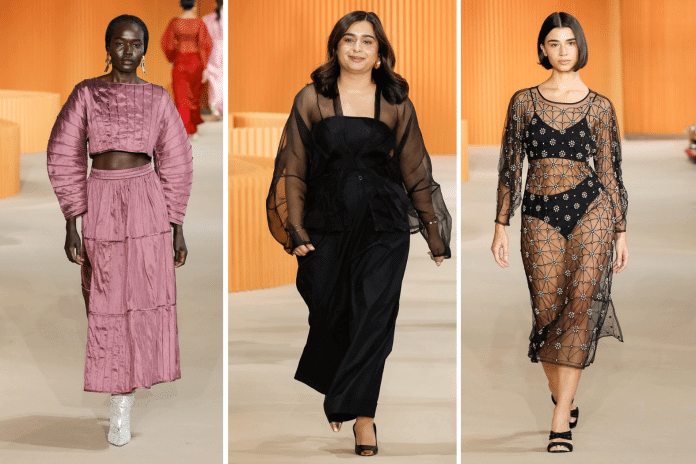If Melbourne designer Kudrat Makkar was chasing a pot of gold with her label MASTANI, she found it this month at Australian Fashion Week (AFW).
In fact, she made it her centrepiece as she sent her models down the runway, a giant urn filled with marigolds that became the first – and last – glimpse of her show, aptly titled ‘Heritage’.
With that name, that floral note, and her own background, you’d think her showcase would be a nod to India.
And you would be right, but not entirely. The highlights came from other factors.
The focus here is on slow fashion, sustainability, and ethical practices, as every garment is meticulously crafted at the in-house MASTANI Atelier in Bengaluru, India. It became the first solo show by an Indian Australian designer at AFW.
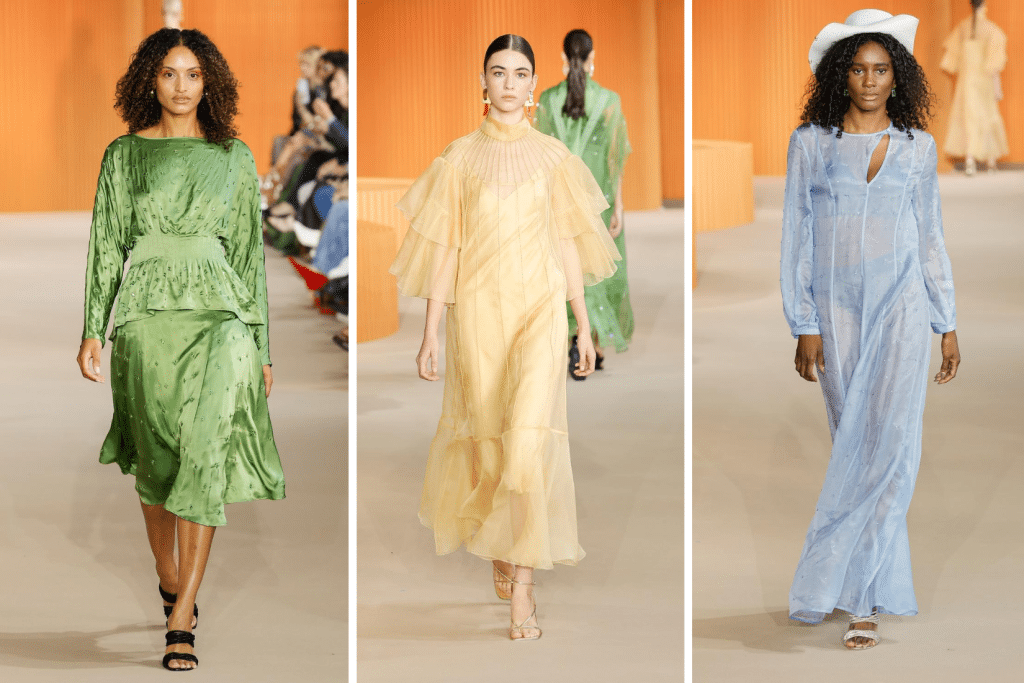
Diversity on the MASTANI catwalk
One of the first elements that stood out for MASTANI at AFW 2024, was the diversity on the runway – in terms of ethnicity, age, body types.
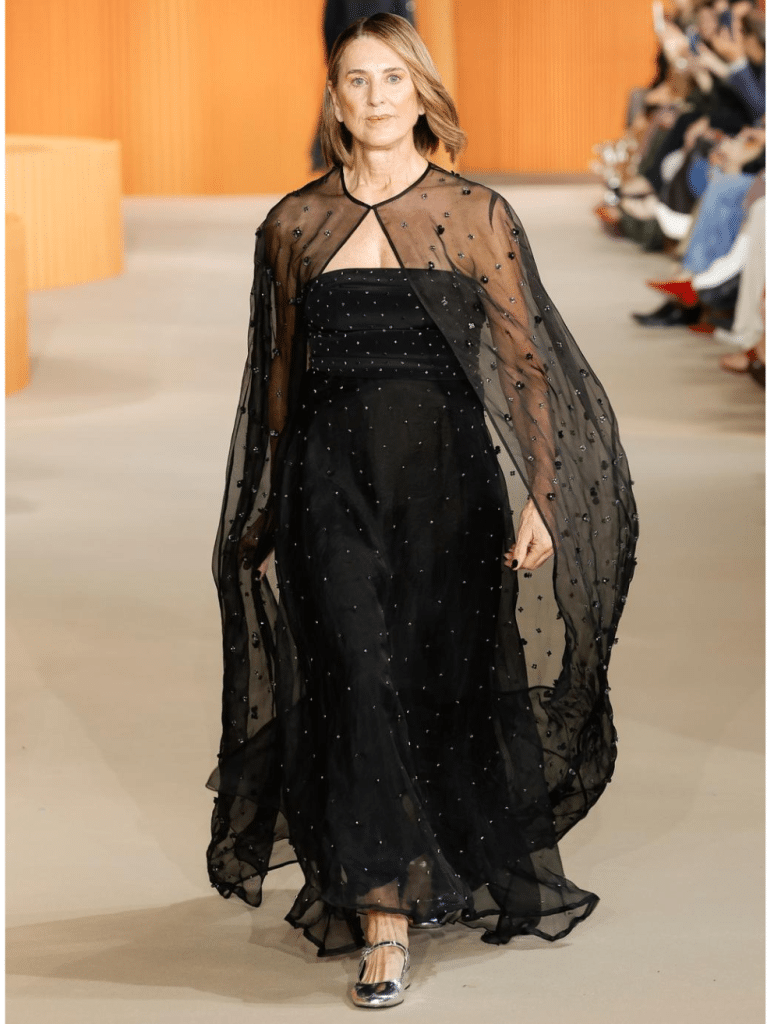
“It’s one of the most talked-about aspects of my show,” Makkar agreed. “I wanted diversity of heritage – all manner of skin tone – and a variety in body size and age. I paid much attention to the casting; that was one of the things that caused the sleepless nights! Not only did I have to source my models from an array of agencies whereas a single agency would have been easier on the purse, I also had to cater for diverse make-up and hair styling!”
While many of her models came from IMG, mature age models came from Silverfox Management, and the African models from Chadwick Models.
Make-up directors were given the heads up to source products for all skin tones, and hair products for all hair styles including the South Asian braid and the African cornrow.
“I wanted some classic silver-haired ladies too,” Makkar revealed. “Kathy Garnaut, a dear friend of the brand, was in the show. She’s in her early 60s and used to model 40 years ago.”
The extra effort went down particularly well, coming in for much appreciation in an industry that prefers Size Six.
The sheer in MASTANI

Besides the wonderful diversity on the catwalk, the diaphaneity in the clothing line was another highlight. MASTANI at AFW 2024
There was plenty of sheer – in dresses, skirts, pants, jackets.
What attracts Makkar to sheer?
“The luminosity, and the different ways you can wear it – with a bodysuit, a slip, or pants,” Makkar offered. “It’s quite feminine, but with strength of character as well.”
The fragility and subtlety of sheer, as well as its elegance and empowerment, are certainly on-trend.
“Sheer is one of my best sellers,” Makar divulged. “Even though my clients range in age from 35-60, they do not all have model bodies, and some are from conservative cultures. Sometimes ladies pull a garment out for a closer look and hesitate, but when urged to try it on, they end up loving it!”
MASTANI’s signature arms
Kudrat Makkar’s structured billowy arms, a MASTANI mainstay and a delight to behold, were on offer yet again.
“My signature arm continues to give and give,” she laughed.
The exaggerated curve detail on the sleeve is an immediate identifier of the classic MASTANI garment, and is Makkar’s own personal favourite.
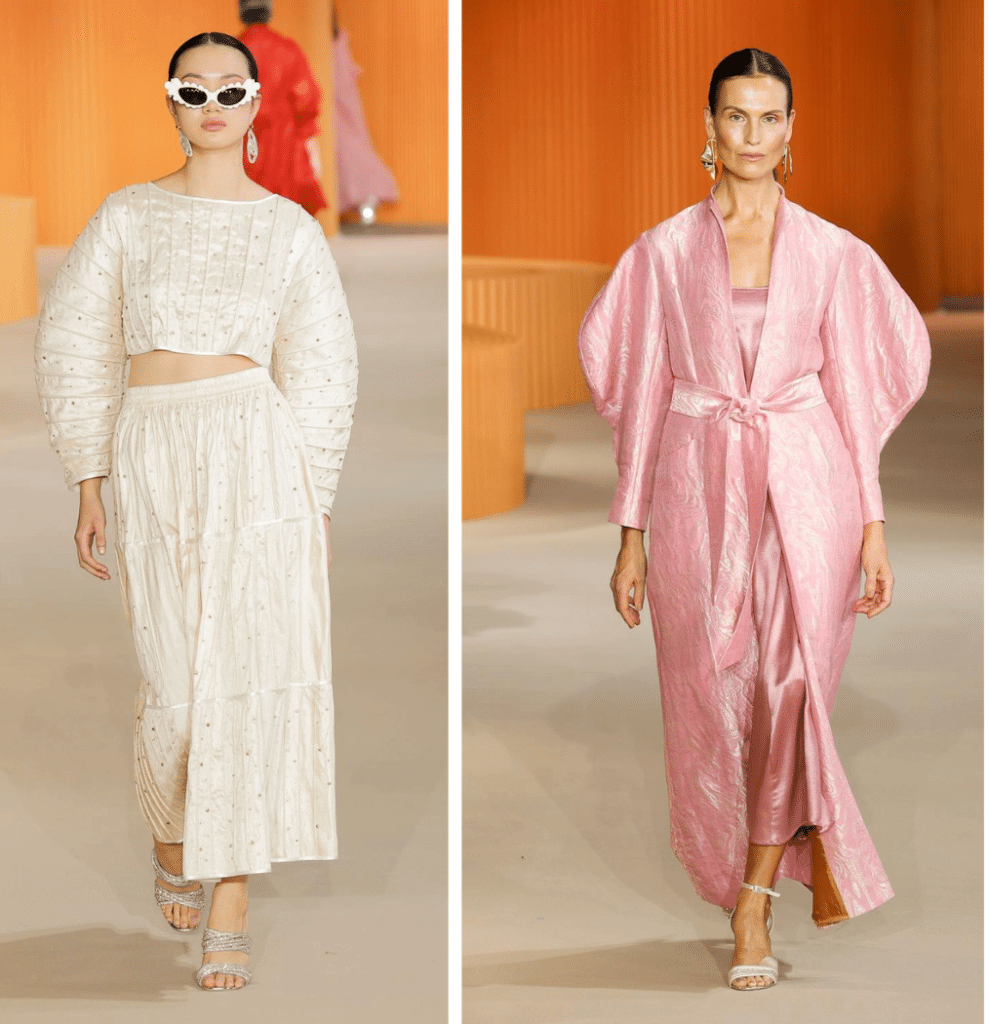
She traces it back to her background in architecture.
“It began when I started the brand six years ago,” she described. “Curves were trending then in the interior design and architecture worlds. A a designer, when some women said to me they didn’t want power shoulders as they felt weighed down, I thought why not put the power in the arms instead, by adding an outstanding curve.”
It was a much smoother curve at the start. “Every season I would make it a little puffier, a little rounder. Now I think we’ve struck the right balance where the proportions work just wonderfully. It works on every body type. I’ve done it now in a sheer fabric.”
Prints, pastels and processes
The incredible marble MASTANI prints were made from natural dyes in Bhuj, Gujarat, and all by hand.
“The artisan works with a large tub of water, pours the paint in, and then moves the paint around. The fabric is laid on top, rested for a second to absorb the patterns, and then picked up and put to dry. The beauty of the imperfections add to the allure. The marble effect is quite different to anything which can be created digitally.”
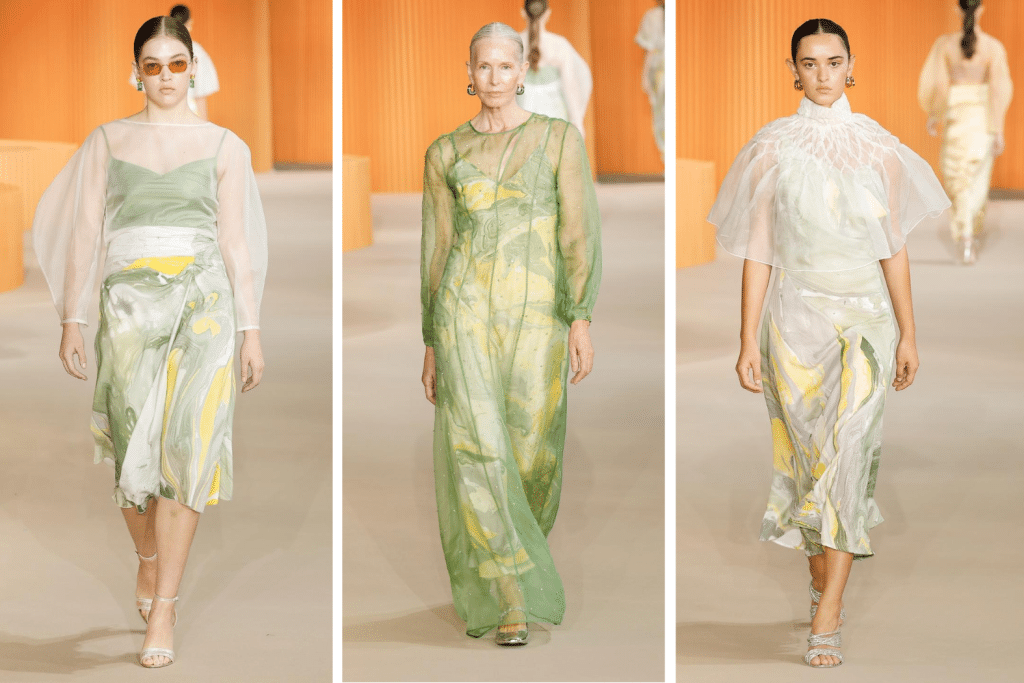
The pastels are another signature MASTANI element.
“This time round the inspiration came from my nostalgia of India and its celebrations. The rose red comes from the opulence of the royal courts, the greens from gardening with my dad. The blues are a reference to my native Punjab and its five rivers; the gold line is an ode to that early evening light, and the beautiful pink is for Jaipur, where I was married.”
The touch of heritage was also seen in the music, such as the earthy Mahi Ve and Jhoom Jhoom.
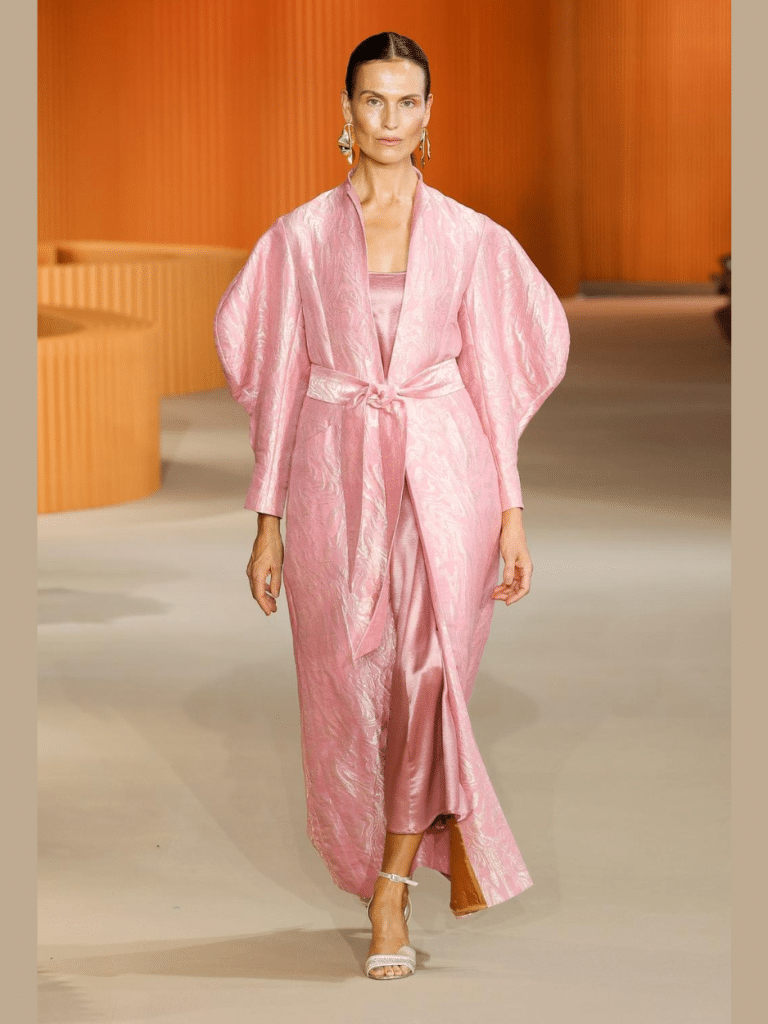
Very much a nod to her culture and to her formative years, it is clear why Makkar calls her latest collection ‘Heritage’.
In fact, ‘Heritage Coat’ is the name given to the first piece that opened the collection.
A stunner in pink handloomed jacquard, it has metallic zari woven through it. Created by artisans in Varanasi, the five metres of fabric alone was twenty one days in the making.
“The inspiration was a digital artwork of a marble print, which the artisans drew by hand, and converted into a punch card for use in the traditional loom.”
The enquiries have been pouring in for this number, which can become a collector’s item in any wardrobe. Interested buyers will have to wait for their order to be filled though – because this is slow fashion.
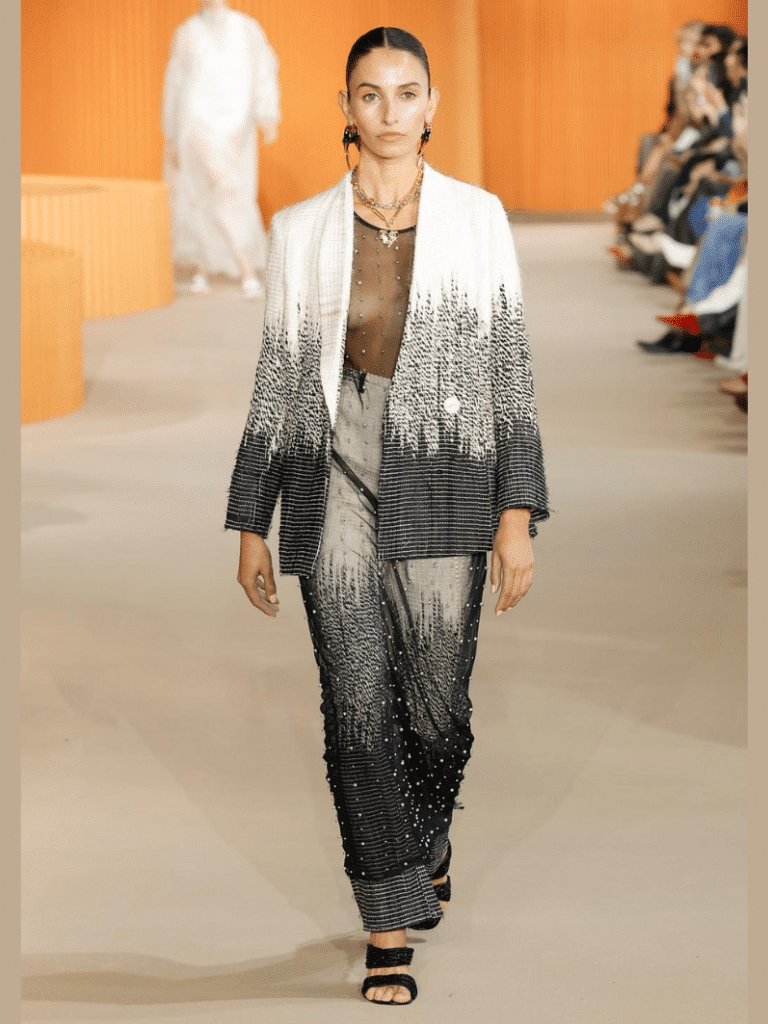
Another number Makkar picked for mention, was an ombre black-and-white pantsuit made of up-cycled materials. Over one ton (1000 kgs) of textile offcuts, trimmings and unused threads were sent to Paiwand Studio, in Noida, India, where they were repurposed into new handloomed fabrics. The endproduct is nothing short of fabulous.
In other heritage links, Makkar showed off artisanal techniques like hand embroidery, mirrorwork, and the use of pearls – but in a manner practical enough for the Australian consumer.
Makkar has no qualms in describing her target audience: they are women who are “well-settled, professional, well-educated; who understand slow fashion and sustainability; who value what I’m doing; who don’t need to be told the story because they can feel it and see it and understand it and they’re happy to pay for it.”
Kudrat Makkar was a rare India-born designer at Australia’s most significant fashion event. Her brand MASTANI has already presented four times at Melbourne Fashion Festival, and to be invited to present at AFW 2024 is a mark of having arrived. Major industry names came on board, such as Jana Bartolo (styling), Kevin Murphy (hair), Amber Moxey (make up), Steve Madden (shoes) and Christina (DJ).
View this post on Instagram
“I’m quite pleased with how it all turned out,” Makkar reflected. “I figured, for my first time, I’d keep it low – compared to the big budget designers who’ve been doing it for many years. But I think it was the tiny details that worked for me.”
Like the marigolds at the centre. MASTANI at AFW 2024
The vase was a giant utensil from a gurudwara (Sikh temple) in Melbourne, weighing 65 kilos. The flowers themselves, not in season, were sourced with much difficulty.
Symbolising vibrancy and positivity, warmth and creativity, power and passion, celebration and auspiciousness, the marigolds stood for the same qualities as the fashion label on display.
READ ALSO: Kudrat Makkar’s MASTANI: A Melbourne fashion brand rises



